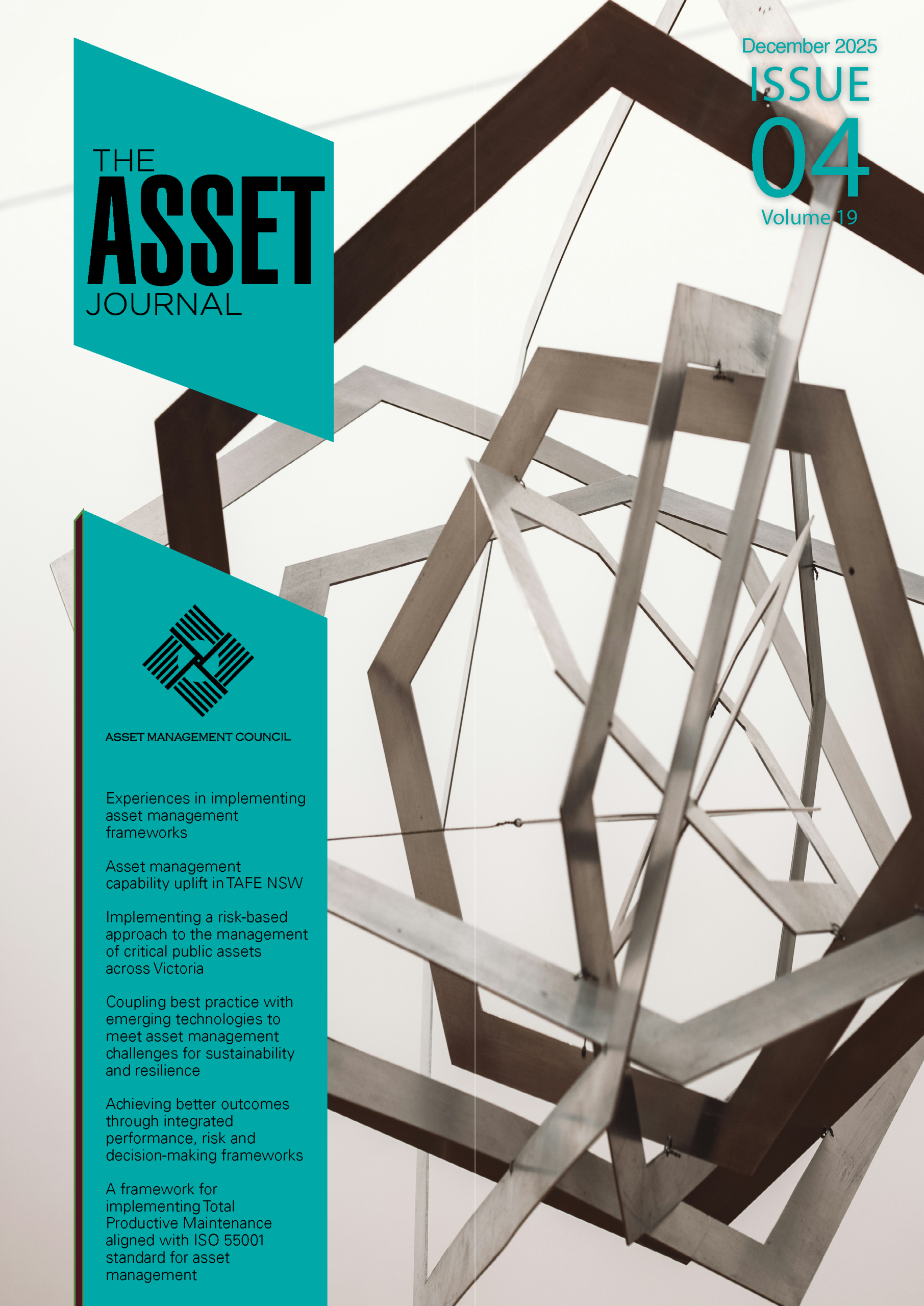Keep informed of the latest developments in Asset Management.

The Asset Journal
Delivered across Australia and available online, the Asset Journal is the AM Council’s official publication boasting topical information on the latest news and developments in asset management and maintenance engineering.
The quarterly journal is respected as an authoritative source of information, containing technical articles, tutorials, and informal articles about current issues in asset management. It also contains information direct from the AM Council – including Local Chapter and Special Interest Group news, and updates from the Editor and Chair.
From the Editor-in-Chief
The Asset Journal, Volume 19, Issue 4

Since the global awareness of Asset Management of physical assets and the implementation of the required frameworks, many organisations have been successful in creating sustainable improvements in their operation. There are many others that adopted an Asset Management framework but require support in revitalising the original framework. What makes the difference between long term success and short term gains? I believe that like all serious changes in organisations, a comprehensive Change Management Plan, strong leadership sponsorship and focused communication and implementation are imperative.
All successful transformations should start with the fundamental question: “Why”. Why is such a change needed and what are the outcomes to be realised? In many relevant cases I observed in Industry intending to implement an asset management system, this clarity of purpose, direction and Leadership was missing. The outcome is predictable…frustration sets in at all levels. In successful implementations of an Asset Management framework, it is evident that the clarity “Why” the change is needed enables successful organisations to align their operations effectively and achieve lasting benefits.
As one example, I recently saw a well-developed Asset Management Framework on a Company’s intranet, with guidelines and templates and some process maps. I thought that this must be clearly a success story in all branches of the organisation. When I asked at the branches how they implemented the system locally, the question was dismissed, stating that one cannot add this burden of changing to an already resource stretched operation. A sad case of value erosion, lost opportunities and loss of return on the investment.
Fortunately, there are numerous examples of success stories. Successful Asset Management System implementations are characterised by active engagement of the Leadership teams, a single point responsibility not only for developing the framework and system but also to guide the necessary communications and implementation. In a recent such project I had the privilege to assist with, there was clear ownership in the Leadership team, they appointed a knowledgeable “Chief Asset Management” position as accountable for the system generation and implementation and tracking progress at top level in the organisation. It seems to me that more Leaders at the Chief Officer level would benefit from better understanding of the value and advantages of Asset Management.
The increased participation we see in activities of Asset Management Societies globally and in Australia in the Asset Management Council is encouraging. These developments suggest that understanding and adoption of asset management practices will continue to mature across public assets and industries. Reinforcement of Asset Management is of course available at AMPEAK in 2026 in Perth and by participation in the many programmes and resources that are provided by the volunteers in the Asset Management Council and its Chapters. We hope to see you at one of these events, but specifically at AMPEAK 2026!
The Asset Journal Issues
| Volume 19, Issue 4 | Download PDF | Volume 19, Issue 3 | Download PDF |
| Volume 19, Issue 2 | Download PDF | Volume 19, Issue 1 | Download PDF |
| Volume 18, Issue 4 | Download PDF | Volume 18, Issue 3 | Download PDF |
| Volume 18, Issue 2 | Download PDF | Volume 18, Issue 1 | Download PDF |
| Volume 17, Issue 4 | Download PDF | Volume 17, Issue 3 | Download PDF |
| Volume 17, Issue 2 | Download PDF | Volume 17, Issue 1 | Download PDF |
| Volume 16, Issue 4 | Download PDF | Volume 16, Issue 3 | Download PDF |
| Volume 16, Issue 2 | Download PDF | Volume 16, Issue 1 | Download PDF |
| Volume 15, Issue 4 | View Online | PDF | Volume 15, Issue 3 | View Online | PDF |
| Volume 15, Issue 2 | View Online | PDF | Volume 15, Issue 1 | View Online | PDF |
| Volume 14, Issue 4 | View Online | PDF | Volume 14, Issue 3 | View Online | PDF |
| Volume 14, Issue 2 | View Online | PDF | Volume 14, Issue 1 | View Online | PDF |
| Volume 13, Issue 4 | View Online | PDF | Volume 13, Issue 3 | View Online | PDF |
| Volume 13, Issue 2 | View Online | PDF | Volume 13, Issue 1 | View Online | PDF |
| Volume 12, Issue 4 | View Online | PDF | Volume 12, Issue 3 | View Online | PDF |
| Volume 12, Issue 2 | View Online | PDF | Volume 12, Issue 1 | View Online | PDF |
| Volume 11, Issue 4 | View Online | PDF | Volume 11, Issue 3 | View Online | PDF |
| Volume 11, Issue 2 | View Online | PDF | Volume 11, Issue 1 | View Online | PDF |
| Volume 10, Issue 4 | View Online | PDF | Volume 10, Issue 3 | View Online | PDF |
| Volume 10, Issue 2 | View Online | PDF | Volume 10, Issue 1 | View Online | PDF |
| Volume 9, Issue 4 | View Online | PDF | Volume 9, Issue 3 | View Online | PDF |
| Volume 9, Issue 2 | View Online | PDF | Volume 9, Issue 1 | View Online | PDF |
| Volume 8, Issue 4 | Download PDF | Volume 8, Issue 3 | Download PDF |
| Volume 8, Issue 2 | Download PDF | Volume 8, Issue 1 | Download PDF |
| Volume 7, Issue 4 | Download PDF | Volume 7, Issue 3 | Download PDF |
| Volume 7, Issue 2 | Download PDF | Volume 7, Issue 1 | Download PDF |
| Volume 6, Issue 4 | Download PDF | Volume 6, Issue 3 | Download PDF |
| Volume 6, Issue 2 | Download PDF | Volume 6, Issue 1 | Download PDF |
| Volume 5, Issue 3 | Download PDF | Volume 5, Issue 2 | Download PDF |
| Volume 5, Issue 1 | Download PDF | Volume 4, Issue 1 | Download PDF |
| Volume 3, Issue 1 | Download PDF | Volume 2, Issue 1 | Download PDF |
| Volume 1, Issue 2 | Download PDF | Volume 1, Issue 1 | Download PDF |
Subscribe
Become a Member of the Asset Management Council or Subscribe to receive an email alert on the release of new editions of the Asset Journal.
Editorial opportunities
We are always looking for thought provoking and informative contributions from members and others in the asset management community, as well as allied professions.
Please contact the Editor in Chief to discuss your potential contribution publications@amcouncil.com.au.
Advertising opportunities
The Asset Journal is the perfect vehicle to expose your product or service to the wider asset management and maintenance engineering community in Australia.
To secure your place in an upcoming edition, please review our Advertising Rates and contact us.















